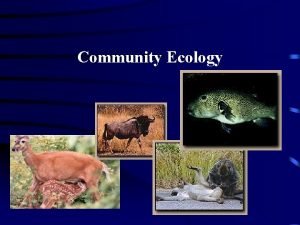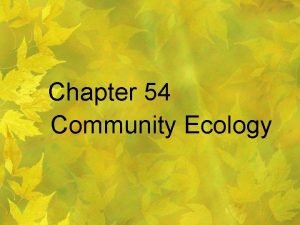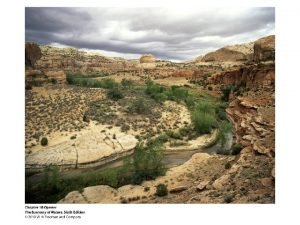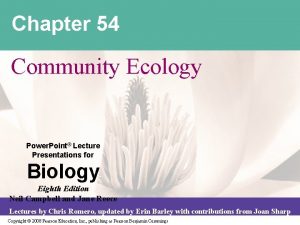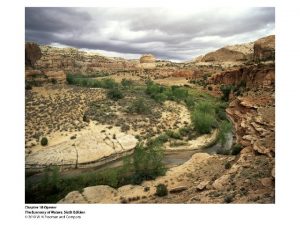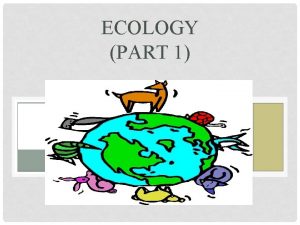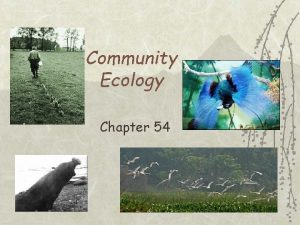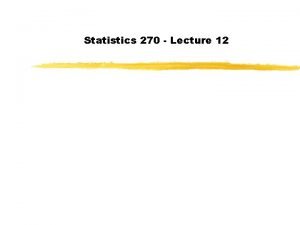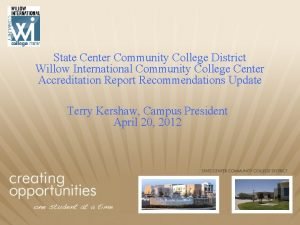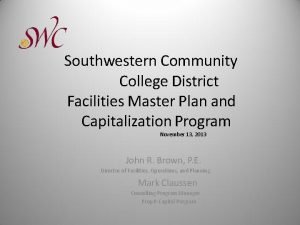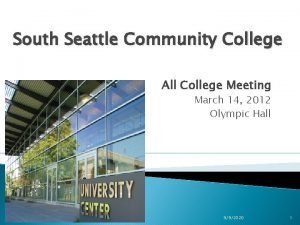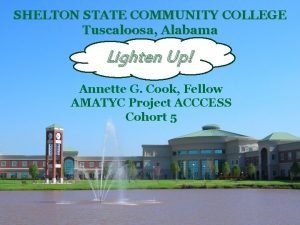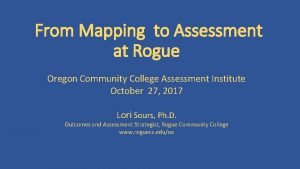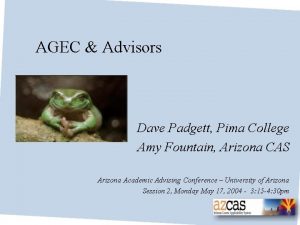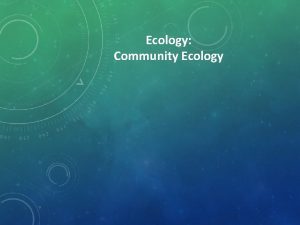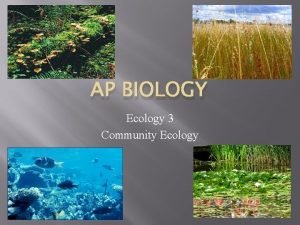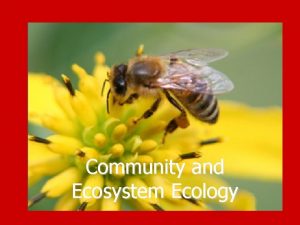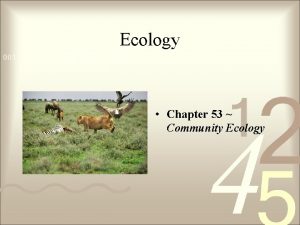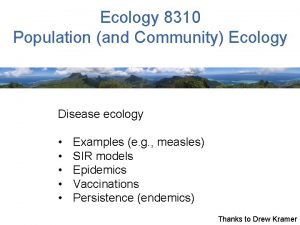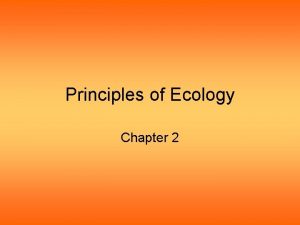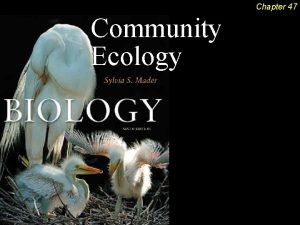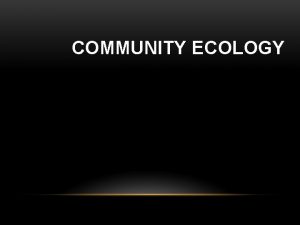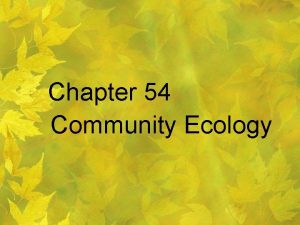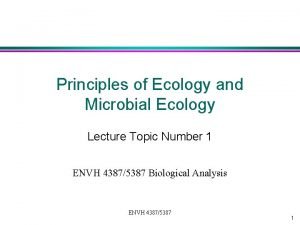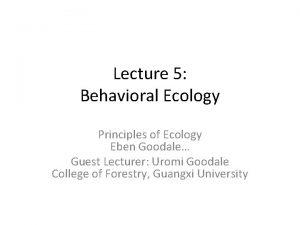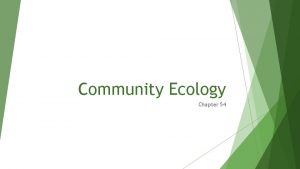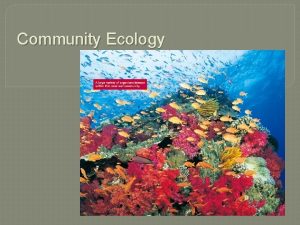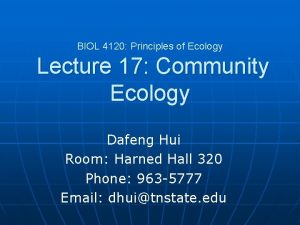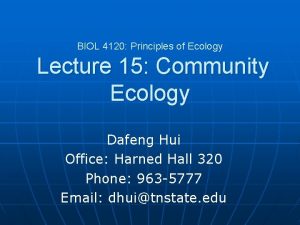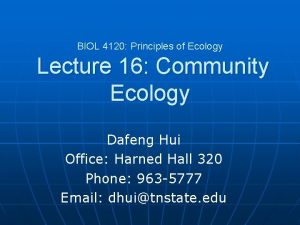Community ecology Lecture 9 Principles of Ecology College






















































- Slides: 54

Community ecology Lecture 9 Principles of Ecology College of Forestry, Guangxi University Eben Goodale

Let’s discuss the midterm exam • Average grade was 80 • • • 3 A (93+) 1 A- (90 -93) 7 B+ (85 -90) 3 B (80 -85) 4 C+ (75 -80) 2 C (70 -75) 1 D+ (65 -70) 3 D (60 -65) 1 F (< 60)

Discussion about Isack and Reyes (1989) • This is a fascinating(迷人的) mutualism( 共栖). • What data do they show to establish that both sides (humans, honeyguides) benefit? • What data do they show to establish that honeyguides communicate(联系) information about the hive(蜂巢) to humans?

Back to our levels slide Characteristics of Individuals? Cold resistant, drought resistant, etc. Also, life history strategies (long life, many offspring) apply to individual.

Back to our levels slide Characteristics of populations? Abundance, distribution, demography. Life history traits also apply (the average values of the individuals in the population)

Back to our levels slide Community Species interactions: -/ - Examples? + / + Examples?

Today’s lecture • What is a community? – How do we know how many species? – Species relative abundance and diversity – Interactions of more then two species – Special species • How do communities change over time? – What is a community: a debate

A community is an association(群组) of interacting species inhabiting(栖息) some defined area. A coral reef community

What is a community? • Is a community a group of species working together, a “super-organism”( 超有机体)? • Are community types very distinct(不同) from each other? • This view held by the ecologist Clements. Frederick Clements (1874 -1945) Community Type A Type B Type C #s of individuals Environmental gradient(环境梯度)

What is a community? • Or do communities grade into each other(平缓地) Henry Gleason , without obvious types. (1882 -1975) • In this view, the members of a community do not work together. No community types • It just happens that they #s live together at a certain of time and place. individuals • This view held by the ecologist Gleason. Environmental gradient Generally, ecologists today are more on the side of Gleason, although there are some cases of discrete community types.

Back to our levels slide Moving on to the community: Characteristics of the community: 1) Number of species 2) Species relative abundances (相对多度) 3) Species diversity(多样性) (1 + 2)

Species number G. Evelyn Hutchinson Yale scientist In 1958, write “A Homage to Santa Rosalia, Or Why are There So Many Kinds of Animals? ” In limestone caves below a reliquary (church) in Palermo, Italy, Hutchinson found 2 species of waterbugs. Why weren’t there 20 species, or 200?

Species number • How many species are there?

To determine species number, need to sample These kind of curves Called species accumulation(积累) curves. Species number Idea is that after a certain Amount of time sampling, you get less and less return in your effort (fewer new species), so should stop. We want to see the line come to an asymptote(渐近线) (level off). Sampling effort

To determine species number, need to sample Which group of species here has the largest number?

Relative abundance of species Community a Species uneven in abundance Community b This relationship can be shown on a rank-abundance curve Species even in abundance Curves for Actual communities Proportional abundance Abundance rank (#1, #2, #3…)

Relative abundance of species Generally, in any typical community there are some very rare species some very abundant species, and most species are average Note that this axis is logarithmic(对数) and thus this pattern is called the “log-normal” distribution Frank Preston 1896 -1989 Spent his life as a engineer for glass manufacture But also wrote 4 very influential scientific papers

Relative abundance of species Lognormal distributions of forest birds: real data Frank Preston 1896 -1989 Spent his life as a engineer for glass manufacture But also wrote 4 very influential scientific papers

Species Diversity Indexes B. Shannon-Wiener Index(多样性指数) Number of species in the community Claude Shannon 1916 -2001. Mathematician famous for information theory Proportion of the ith species natural logarithm

speci es # % % log (%) 1 21 0. 84 -0. 17 -0. 15 2 1 0. 04 -3. 22 -0. 13 3 1 0. 04 -3. 22 -0. 13 4 1 0. 04 -3. 22 -0. 13 5 1 0. 04 -3. 22 -0. 13 -0. 66 H' = 0. 661 25 speci es log (%) # 1 5 0. 2 -1. 61 -0. 32 2 5 0. 2 -1. 61 -0. 32 3 5 0. 2 -1. 61 -0. 32 4 5 0. 2 -1. 61 -0. 32 5 5 0. 2 -1. 61 -0. 32 -1. 61 H' = 1. 609 25 I expect you to be able to calculate this index.

Dealing with more than 2 species (linear) Interactions can be linear… or circular. (circular)

Dealing with more than 2 species There can be indirect interactions. Trophic cascade(营养级)

Dealing with more than 2 species Food webs(食物网) and interaction webs show interactions between many species.

Food webs and trophic cascades Primary reading for Next lecture: “Ecological meltdown (危机) in predator free forest fragments” Can get very complicated! Estes et al. 1998 What happens to communities when big cats removed?

Special Species(特有种) • Species that have a major role in a community – Dominant species. – Keystone species. – Ecosystem engineers. In network(网状) structure, some species may be more important than others.

Special Species • “Dominant” species – Are those species in a community that are most abundant or have the highest biomass(生物量) – Exert powerful control over the occurrence and distribution of other species A salt marsh Redwood forest A mangrove forest

Special Species • Keystone species(关键种): one that exercises a large amount of influence on the community compared to its biomass. Sea otters: top of the trophic cascade Fig trees: fruit for animals thoughout the year. Pisaster starfish: By predation keeps diversity in system (lowers numbers of good competitors)

Special Species 8 Number of plant species • Foundation species act as facilitators that have positive effects on the survival and reproduction of some of the other species in the community. • Ecological engineers ( 程师)exert their influence by causing physical changes in the environment that affect community structure. 6 4 2 0 Salt marsh with Juncus (foreground) With Juncus Without Juncus

Special Species The beaver as a ecosystem engineer

Today’s lecture • What is a community? – How do we know how many species? – Species relative abundance and diversity – Interactions of more then two species – Special species • How do communities change over time?

Community Dynamics(群落动态) Are the physical and biological characteristics of a community static? • Famous example of dunes near a lake. • Sand continually blown ashore and gradually dunes get bigger. • Walking away from the coast one encounters older and older communities.

Community Dynamics Are the physical and biological characteristics of a community static? • Or, glacier(冰川) retreats over time. • Walking away from glacier one encounters older and older communities. • How do communities respond to disturbance?

What is a disturbance(干扰)? Mt St. Helens 1980 Where do human activities fit?

What is a disturbance?

Primary vs. secondary succession (初级和次级演替) • Primary succession: Colonization of habitats devoid of life (e. g. , volcanic rock). • Secondary succession: Reestablishment of a community in which some, but not all, organisms have been destroyed. After a glacier: primary An old field: secondary succession

What does succession lead to? • Clements: succession is like the development of an organism with a birth, a middle age and an end stage. • The end stage is a “climax community(顶级群落) ”. Recently retreated glacier Dryas mat (~ 30 years) Frederick Clements (1874 -1945) Alder thicket (50 yrs) Spruce forest (~ 100 yrs)

What does succession lead to? But actually not so simple: there can be multiple different kinds of climax communities depending on environmental conditions Muskeg (~ 200 yrs) Climax community in wetlands Mature hemlock forest (~ 200 yrs) Climax community on slopes

And how does succession progress? • Clements: the different species help each other. • For example, the first “pioneer(先锋种)” plants help make soil richer for what comes later. Frederick Clements (1874 -1945)

But again perhaps more complicated Connell and Slatyer 1977 • Facilitation(简易化) can occur: early organisms help later ones. • Tolerance (忍受力) can occur: early organisms don’t have much of an effect on later ones, but later ones live longer. • Early organisms might even inhibit(抑制) later ones under some circumstances

But again perhaps more complicated In general, facultative interactions dominate early in succession, And inhibitive late in succession.

Sometimes succession gets “stuck(困住)” This is when typical succession is altered, so that never get to climax community. Some parts of community act to inhibit establishment of others. Fernlands in Sri Lanka stop succession Coral reef overgrown by algae This particularly happens due to human disturbance and is called a “regime shift”. Without intervention these regime shifts can be permanent (永恒).

Over time, community grews more complex More species More nutrients

Disturbances range in Frequency(频率), intensity(强度) and extent(范围) • So far we have talked about large disturbances. • But small disturbances, like large trees falling over in the rainforest are also important.

Disturbances range in frequency, intensity and extent • My wife Uromi studies the pioneer trees that live in tree fall gaps. • Just like weeds, these trees like light, grow fast, and have many small seeds. • In contrast, “late-successional(推 迟演替)” species are more tolerant(忍耐) of shade. • Tree fall gaps create a mosaic(镶 嵌) of places in the forest of different successional ages.

Disturbances also different time scales Glacier bay ~ 1500 years Inter-tidal succession 1. 5 years Old temperate field ~ 150 yrs Sycamore Creek 60 days

Where we are going • Today we talked about how to measure species diversity, and how it changes in one place over time. • On Tuesday Apr 28 we talk about how species diversity varies across big regions (high near equator) and in islands of different sizes (a famous theory called “island biogeography”). • On Saturday May 2 we talk about how species diversity varies within a region. Why is it higher in some communities than others? Island Biogeography Theory Heterogeneous Habitat Theory

Homework • Chapter 18 summary • Primary reading: Terborgh et al. 2001. Prepare to discuss in class next lecture.

Key concepts • An old viewpoint is that a • We use species community is a super-organism accumulation curves to made up of species that work estimate how many species. together. • Species differ in their • It is true that a community has a abundances; species predictable succession after diversity indices combine disturbance, and that facilitation the number of species with (species helping each other) is their abundance. common early in this process. • Some species may • But it also true that there are particularly important role multiple endpoints possible, and in a community. that species can also not help (tolerate) or even inhibit each other.

Tips for listening, reading Listening: http: //www. artsci. utoront o. ca/current/advising/ell/ pdfs/ELL_Strengthening_L istening_Comprehension. pdf Reading to write: http: //www. artsci. utoront o. ca/current/advising/ell/ pdfs/Reading_to_Write_P reviewing. pdf

OK, so communities differ in species diversity … but why? • We will come back to this question, but today just introduce an idea called “heterogeneous environmental theory”. • First developed by Robert Mac. Arthur • Came out of the idea of niches, and the competitive exclusion theory • Mac. Arthur generally Robert Mac. Arthur Student of Hutchinson worked with birds Died at age of 42 in 1972

Heterogeneous Environments: Opportunities for Specialization Remember that each species has a niche – Its occupation. In these birds that Mac. Arthur studied each species uses different part of the tree. And no two species can have the same niche “competitive exclusion principle”. We talked about this when talking about competition

So it makes sense that the higher the canopy of forests, the more species there will be. This was Mac. Arthur’s first result (1958)

Further experiments demonstrate that vertical heterogeneity increases species diversity Mac. Arthur hung a rope vertically from the top of the canopy and measured how many times vegetation hit the rope. From this he calculated vertical profiles of different forests, and compared them in their diversity (# of different layers and evenness of layers). Mac. Arthur and Mac. Arthur 1961

Further experiments demonstrate that vertical heterogeneity increases species diversity He found that the more diverse the vertical vegetation the more species of birds were present Mac. Arthur and Mac. Arthur 1961 Species diversity Is a fascinating subject and we will look at it In more detail later In the course.
 01:640:244 lecture notes - lecture 15: plat, idah, farad
01:640:244 lecture notes - lecture 15: plat, idah, farad Is india near the equator
Is india near the equator Population vs community ecology
Population vs community ecology Community ecology
Community ecology Chapter 3, section 1: community ecology answer key
Chapter 3, section 1: community ecology answer key Chapter 54: community ecology answer key
Chapter 54: community ecology answer key 5 evolution and community ecology
5 evolution and community ecology Definition of community ecology
Definition of community ecology More diverse
More diverse Chapter 5 evolution and community ecology
Chapter 5 evolution and community ecology Chapter 5 evolution and community ecology answer key
Chapter 5 evolution and community ecology answer key Community definition ecology
Community definition ecology An organisms rank in a feeding hierarchy
An organisms rank in a feeding hierarchy Symbiosis examples
Symbiosis examples Chapter 54 community ecology
Chapter 54 community ecology A college professor never finishes his lecture
A college professor never finishes his lecture Principles of economics powerpoint lecture slides
Principles of economics powerpoint lecture slides Objective of comparative education
Objective of comparative education Chapter 2 principles of ecology
Chapter 2 principles of ecology Principles of ecology 1 organisms and their relationships
Principles of ecology 1 organisms and their relationships Chapter 2 principles of ecology answer key
Chapter 2 principles of ecology answer key Section 1 organisms and their relationships
Section 1 organisms and their relationships Principles of ecology chapter 2 section 1 answer key
Principles of ecology chapter 2 section 1 answer key Principles of ecology 2 flow of energy in an ecosystem
Principles of ecology 2 flow of energy in an ecosystem Community action cycle
Community action cycle Woodland community college counseling
Woodland community college counseling Chesterton community college
Chesterton community college Willow international community college
Willow international community college Willow international community college
Willow international community college Southwestern community college
Southwestern community college Shoreline community college nursing
Shoreline community college nursing Moraine valley admissions
Moraine valley admissions Community college business officers
Community college business officers Lahc verify my fafsa
Lahc verify my fafsa Johnson county community college nursing
Johnson county community college nursing Glendale community college library hours
Glendale community college library hours Gcc nursing program prerequisites
Gcc nursing program prerequisites Glendale community college nursing program
Glendale community college nursing program My gcc glendale
My gcc glendale National community college benchmark project
National community college benchmark project Tarrant county college - northeast campus
Tarrant county college - northeast campus Aims community college cpat
Aims community college cpat Wallace community college scholarships
Wallace community college scholarships Uwt parking pass
Uwt parking pass South seattle community college
South seattle community college Apartments near shelton state community college
Apartments near shelton state community college Ccd radiology
Ccd radiology Hotels near paradise valley community college
Hotels near paradise valley community college Web advisor norco
Web advisor norco Glendale community college transcript
Glendale community college transcript Rogue community college map
Rogue community college map Bergen community college academic advising
Bergen community college academic advising Pima community college advisors
Pima community college advisors George c wallace community college
George c wallace community college Wayne community college library
Wayne community college library



